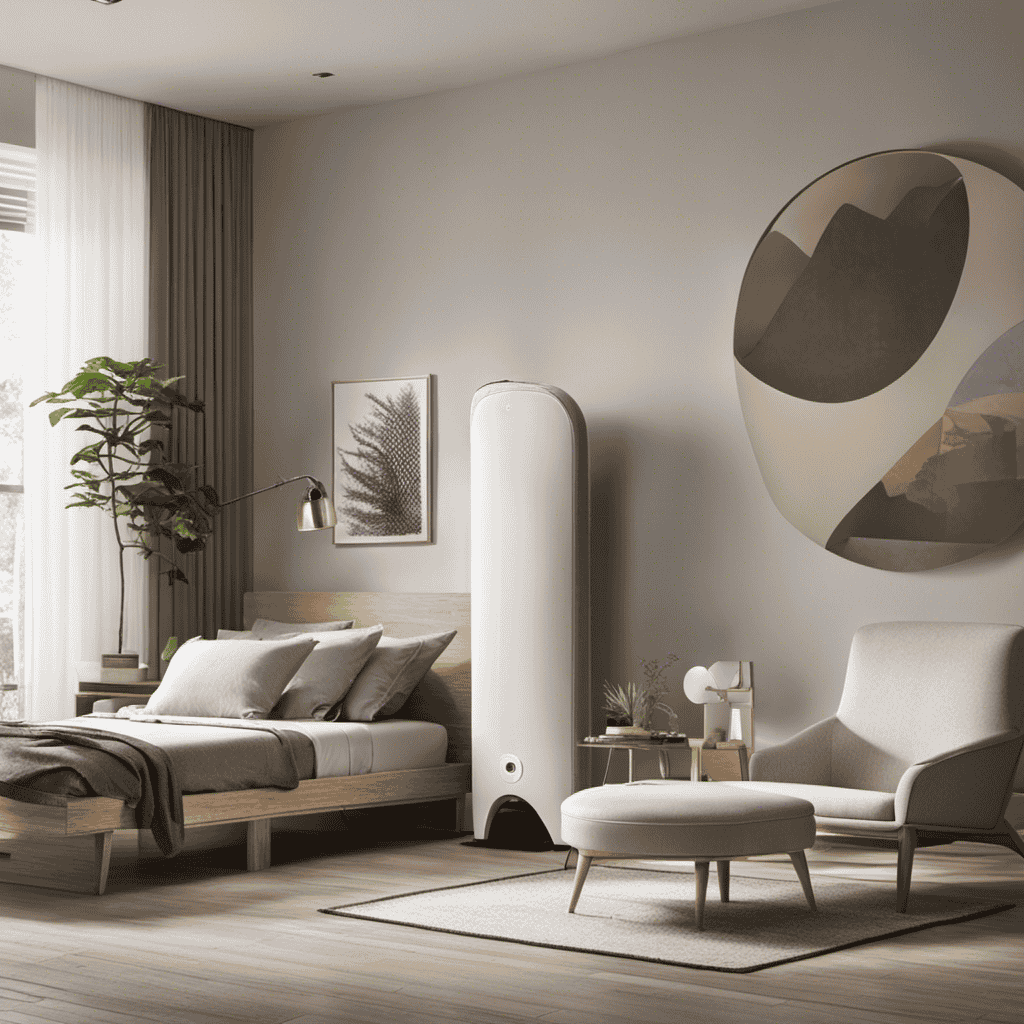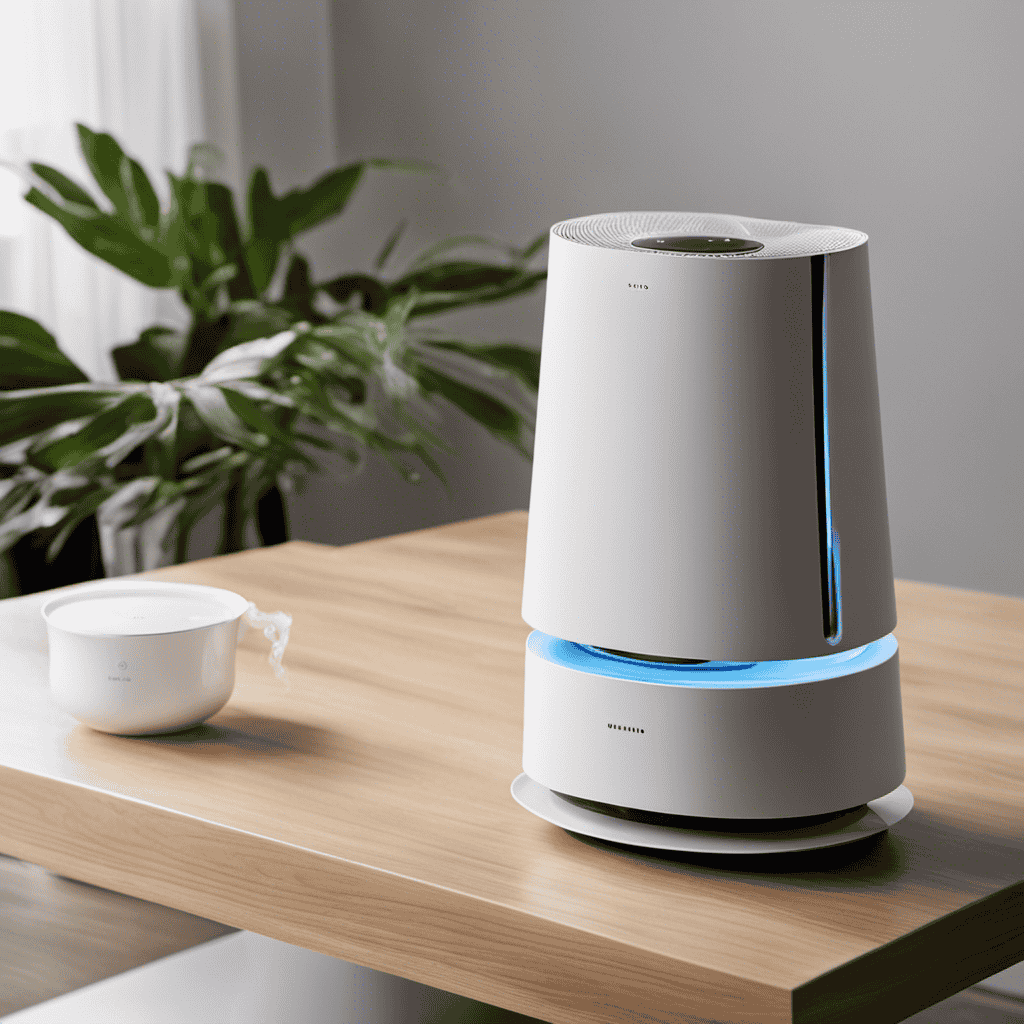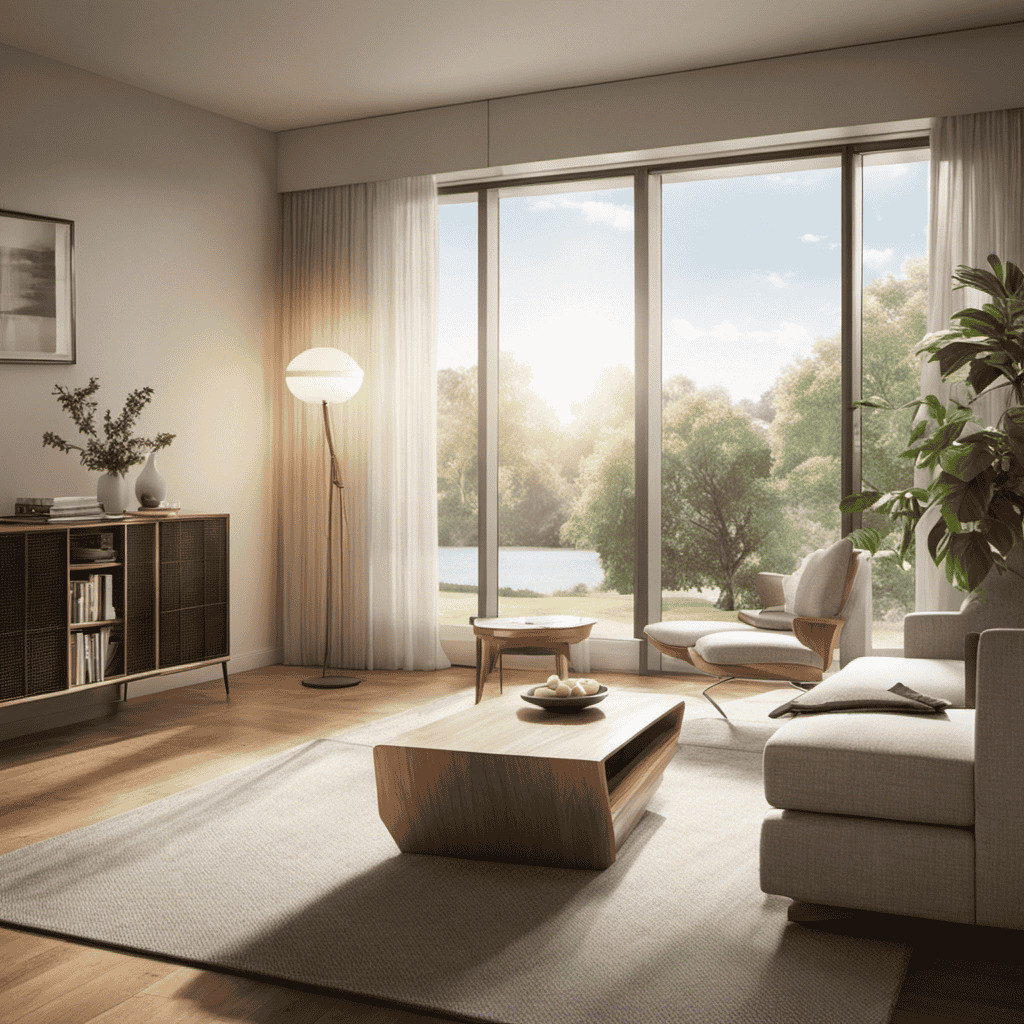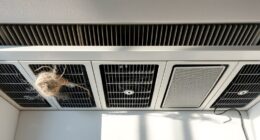You have purchased an air purifier to enhance the air quality in your home. Now you may be wondering, how long should you run it for?
Well, let me tell you, my friend, that the answer isn’t as straightforward as it may seem. There are various factors to consider, such as the size of your space, the air quality in your area, and your specific health needs.
In this article, we will dive deep into the world of air purifiers to help you determine the recommended duration for running yours.
Key Takeaways
- Choose the right air purifier for specific pollutants in your home
- Consider the size of your space for optimal purification
- Balance runtime with energy efficiency to minimize energy waste
- Regularly replacing air purifier filters is crucial for maintaining optimal air quality
The Importance of Running an Air Purifier
The importance of running an air purifier is that it helps to improve indoor air quality. When it comes to factors affecting air purifier effectiveness, there are a few key considerations to keep in mind.
First and foremost, it’s crucial to choose the right air purifier for your home. Different air purifiers are designed to target specific pollutants, such as dust, allergens, or odors. By selecting the appropriate purifier, you can ensure that it effectively addresses the specific air quality issues in your home.
Additionally, factors like the size of your space, the level of pollution, and the frequency of use can all impact the effectiveness of your air purifier. Considering these factors will help you make the most informed decision and achieve optimal results.
Now, let’s delve into the factors to consider when running an air purifier.
Factors to Consider When Running an Air Purifier
When considering factors, it’s important to think about how often to use your air purifier.
There are several factors to consider when determining the optimal runtime for your air purifier.
Firstly, you should consider the size of the room or area you want to purify. A larger space will require longer runtime to effectively clean the air.
Additionally, you should take into account the air quality in your environment. If you live in an area with high pollution or allergens, you may need to run the air purifier for longer periods of time.
It is also important to consider your own health needs and sensitivities. Regular use of an air purifier can provide numerous benefits, such as reducing airborne allergens, improving respiratory health, and creating a healthier living environment.
Therefore, it is crucial to strike a balance between runtime and the benefits of clean air.
Recommended Duration for Running an Air Purifier
To ensure optimal air quality, consider the recommended duration of running an air purifier. The duration for running an air purifier depends on various factors such as the size of the room, the level of air pollution, and the specific needs of the occupants. Here are some guidelines to help you determine the recommended duration for running an air purifier:
-
Room size: For smaller rooms, running the air purifier for a few hours a day may be sufficient. However, for larger rooms, it is recommended to run the air purifier for longer periods to ensure effective air purification.
-
Level of air pollution: If you live in an area with high levels of air pollution, it is advisable to run the air purifier for longer durations to continuously filter and clean the air.
-
Specific needs: Individuals with allergies or respiratory conditions may benefit from running the air purifier for extended periods, especially during peak allergy seasons or when experiencing symptoms.
-
Energy consumption: While it is important to ensure clean air, it is also important to consider energy consumption. It is recommended to balance the duration of running the air purifier with energy efficiency to minimize energy waste.
How Often Should You Run Your Air Purifier
Consider running your air purifier for shorter durations in smaller rooms and for longer durations in larger rooms. The recommended frequency for running your air purifier depends on the size of the room and the air quality in your home.
In general, it is best to run the air purifier for at least a few hours every day to maintain clean air. However, if you have a larger room or if the air quality is poor, you may need to run it for longer periods of time.
It is also important to choose the best time to run your air purifier. Running it during times when the room is not occupied, such as when you are at work or sleeping, can help ensure that you are breathing clean air without disrupting your daily activities.
Understanding the air quality in your home is crucial in determining the appropriate frequency and duration for running your air purifier.
Understanding the Air Quality in Your Home
Understanding the air quality in your home is essential for determining how often and how long to use your air purifier. By understanding the levels of air pollution in your indoor environment, you can make informed decisions about the usage of your air purifier to improve the indoor air quality.
Here are some key points to consider:
-
Sources of air pollution: Identify the potential sources of air pollution in your home, such as smoking, cooking, pets, or chemical products.
-
Monitoring air quality: Use air quality monitors to measure the levels of pollutants, such as particulate matter, volatile organic compounds (VOCs), and carbon dioxide.
-
Health effects: Understand the health risks associated with poor indoor air quality, such as respiratory issues, allergies, and asthma.
-
Improving air quality: Implement effective strategies to improve indoor air quality, including proper ventilation, regular cleaning, and using air purifiers.
Benefits of Running an Air Purifier Continuously
Running an air purifier continuously can greatly improve the air quality in your home, reducing the presence of pollutants and allergens.
When considering the benefits of running an air purifier, it is important to understand the factors that can affect its performance. Factors such as the size of the room, the level of pollutants in the air, and the quality of the air purifier itself can all impact its effectiveness.
Additionally, cost-effective air purifier options are available in the market, allowing you to improve your indoor air quality without breaking the bank.
Is It Necessary to Run an Air Purifier 24/7
It’s important to determine whether running an air purifier 24/7 is necessary for maintaining optimal air quality in your home. To answer this question, let’s take a look at some key findings from an air purifier effectiveness study:
- Air purifiers are most effective when running continuously, as they can capture and remove airborne particles and pollutants constantly.
- Running an air purifier at night can be particularly beneficial, as it helps to improve the air quality in your bedroom while you sleep, ensuring you breathe in cleaner air throughout the night.
- Some air purifiers have a sleep mode feature, which operates at a lower fan speed and noise level, making it ideal for nighttime use.
- Running an air purifier 24/7 may be necessary in homes with high levels of indoor pollutants, such as those located near busy roads or in areas with poor outdoor air quality.
The Role of Air Purifiers in Allergen Control
When it comes to controlling allergens in the air, there are various techniques that can be employed.
One of the most effective methods is using air purifiers, which have been proven to significantly reduce allergens such as pollen, dust mites, and pet dander.
The effectiveness of air purifiers in removing these allergens not only provides relief for allergy sufferers but also offers numerous health benefits, including improved respiratory function and reduced risk of asthma attacks.
Allergen Reduction Techniques
To reduce allergens in your home, you should consider using air purifiers with HEPA filters. These devices are highly effective in removing airborne particles, such as dust, pollen, pet dander, and mold spores.
Here are four important tips for maintaining and replacing air purifier filters:
- Regular Cleaning: Clean the pre-filter and dust off the exterior of the unit to improve its efficiency.
- Filter Replacement: Follow the manufacturer’s instructions to replace the filters at recommended intervals.
- Monitor Filter Life: Some air purifiers have indicators that alert you when it’s time to replace the filters.
- Vacuuming: Vacuum the area around the air purifier regularly to prevent dust buildup.
By following these maintenance practices, you can ensure that your air purifier remains effective in reducing allergens in your home.
Now, let’s explore the effectiveness of air purifiers in more detail.
Air Purifier Effectiveness
Using air purifiers with HEPA filters can significantly reduce airborne allergens in your home. However, it is important to understand that the effectiveness of an air purifier depends on proper maintenance and regular filter replacement. Neglecting these tasks can diminish the purifier’s performance and compromise the quality of air in your home.
To ensure optimal functioning, it is recommended to follow a regular maintenance schedule for your air purifier. This includes cleaning the exterior surfaces, checking the fan and motor for any obstructions, and inspecting the filter for dirt and debris. Depending on the manufacturer’s instructions, filters may need to be replaced every 6 to 12 months.
To emphasize the importance of air purifier maintenance and filter replacement, here is a table that highlights the potential consequences of neglecting these tasks:
| Neglected Maintenance/Filter Replacement | Consequences |
|---|---|
| Dirty filter | Reduced air purification effectiveness |
| Clogged fan/motor | Decreased airflow and performance |
| Accumulated dirt and debris | Increased risk of airborne allergens |
Health Benefits of Purifiers
Ensure that regular maintenance is performed on your purifier to maximize the health benefits it provides. By properly maintaining your air purifier, you can ensure its effectiveness in reducing allergens and improving the overall air quality in your home.
Here are four key maintenance practices that will help you achieve optimal results:
- Regularly clean or replace the filters to ensure efficient removal of airborne particles and allergens.
- Clean the exterior of the purifier to prevent the buildup of dust and dirt, which can hinder its performance.
- Check and clean the air vents to ensure proper airflow and prevent clogging.
- Monitor the purifier’s performance and schedule professional servicing if necessary to maintain its efficiency and effectiveness.
Running an Air Purifier During Allergy Season
Running an air purifier during allergy season can help alleviate symptoms and improve air quality in your home. To ensure optimal performance and longevity of your air purifier, regular maintenance is essential. This includes cleaning or replacing the filters according to the manufacturer’s instructions. Additionally, choosing the right air purifier for your specific needs is crucial. Consider factors such as the size of the room, the type of allergens you want to remove, and the noise level you can tolerate. To assist you in making an informed decision, here is a comparison table of different air purifiers:
| Air Purifier Model | Coverage Area | Filter Type | Noise Level |
|---|---|---|---|
| Model A | 500 sq. ft. | HEPA | 40 dB |
| Model B | 300 sq. ft. | Carbon | 50 dB |
| Model C | 700 sq. ft. | Ionic | 35 dB |
| Model D | 400 sq. ft. | UV-C | 45 dB |
How Long to Run an Air Purifier for Odor Removal
To effectively remove odors, it’s important to run the air purifier in the designated area for a sufficient amount of time. When it comes to odor elimination, there are a few key factors to consider. Here are some tips to ensure effective air purification:
-
Placement: Position the air purifier in the area where the odor is most prevalent. This allows the device to capture and filter the air effectively.
-
Run Time: Run the air purifier continuously for a minimum of 8 hours or as directed by the manufacturer. This ensures that the air is thoroughly filtered and the odors are eliminated.
-
Filter Maintenance: Regularly clean or replace the filters as recommended. This keeps the air purifier functioning optimally and prevents odors from lingering.
-
Room Size: Consider the square footage of the room and choose an air purifier that is suitable for that size. A properly sized air purifier will be more efficient in removing odors.
Air Purifier Run Time for Pet Owners
For pet owners, it’s important to consider the recommended run time of an air purifier to effectively eliminate pet odors. When it comes to pet dander control and air purification techniques, running the air purifier for extended periods can be beneficial.
Pet dander, which includes tiny flecks of skin and fur, can easily become airborne and cause allergies and odors. By running the air purifier continuously, you can ensure that the pet dander is constantly filtered out of the air, keeping it clean and fresh.
It’s recommended to run the air purifier for at least 8 to 12 hours a day to achieve optimal results. This prolonged run time allows the air purifier to effectively capture and eliminate pet dander, reducing allergens and odors in your home.
Air Purifier Usage for Asthma and Respiratory Health
If you’re concerned about your asthma or respiratory health, it’s essential to consider how an air purifier can help. Here are four reasons why an air purifier is beneficial for asthma management and respiratory conditions:
-
Removes airborne allergens: An air purifier can capture and eliminate common triggers like dust mites, pollen, and pet dander, reducing the risk of asthma attacks.
-
Filters out pollutants: Indoor air can contain harmful particles like smoke, VOCs, and pollutants from cleaning products. An air purifier can effectively remove these pollutants, improving respiratory health.
-
Reduces mold spores: Mold spores can worsen respiratory conditions. An air purifier with a HEPA filter can capture and eliminate mold spores, preventing their spread and reducing the risk of respiratory issues.
-
Improves air quality: Air purifiers circulate and filter the air, ensuring cleaner and fresher air indoors. This can benefit asthma management and overall respiratory health.
With these benefits in mind, running an air purifier for mold prevention becomes crucial in maintaining a healthy indoor environment.
Running an Air Purifier for Mold Prevention
Running an air purifier with a HEPA filter helps prevent the spread of mold spores and maintains a healthier indoor environment. Mold prevention techniques are essential to ensure the safety and well-being of our homes. Mold can cause various health issues and can be particularly harmful to individuals with respiratory conditions.
By continuously running an air purifier, we can effectively filter out mold spores and reduce their presence in the air. However, it is crucial to regularly maintain the air purifier to ensure its optimal performance. This includes regularly changing the HEPA filter and cleaning the unit to prevent the accumulation of mold and other contaminants.
Proper air purifier maintenance will ensure that it continues to provide clean and fresh air, reducing the risk of mold growth and improving overall indoor air quality.
Optimizing Energy Efficiency With Air Purifiers
Using an air purifier with energy-saving features can help reduce electricity consumption while maintaining clean indoor air quality. Here are some energy-saving tips and air purifier maintenance practices to optimize efficiency:
-
Set a timer: Utilize the timer function on your air purifier to automatically turn it off when you don’t need it. This helps conserve energy by preventing unnecessary runtime.
-
Clean or replace filters: Regularly clean or replace the filters in your air purifier as recommended by the manufacturer. This ensures optimal airflow and efficiency.
-
Choose the right size: Select an air purifier that is appropriately sized for the room you intend to use it in. An oversized purifier may consume more energy than necessary.
-
Keep it well-maintained: Regularly clean the exterior and vents of your air purifier to prevent dust buildup, which can hinder its performance and increase energy consumption.
Creating a Healthy Home Environment With an Air Purifier
When it comes to optimizing the runtime of an air purifier, it is important to consider the specific needs of your home environment.
Factors such as the size of the space, the level of air pollution, and the sensitivity of individuals to allergens can all play a role in determining the optimal runtime.
Optimal Air Purifier Runtime
To maximize air purification, it’s best to keep the air purifier running for extended periods of time. Here are some key factors to consider for optimal air quality and air purifier maintenance:
-
Consistency: Running the air purifier consistently ensures continuous purification of the air in your home.
-
Room size: The runtime of the air purifier depends on the size of the room. Larger rooms may require longer runtime to effectively purify the air.
-
Pollutant level: If the air in your home has a high level of pollutants, such as allergens or odors, it’s advisable to run the air purifier for longer periods to effectively remove these contaminants.
-
Filter replacement: Regularly replacing the air purifier filters is crucial for maintaining optimal air quality. Check the manufacturer’s instructions for recommended filter replacement intervals.
Benefits of Clean Air
Breathing clean air has numerous benefits for my overall health and well-being.
Improving indoor air quality is essential to ensure that the air I breathe is free from pollutants and allergens that can negatively impact my health. Clean air helps to reduce the risk of respiratory issues such as asthma and allergies. It also promotes better sleep, enhances cognitive function, and boosts my immune system.
By removing harmful particles and improving ventilation, clean air creates a healthier and more comfortable living environment. Additionally, it can reduce the symptoms of chronic conditions like COPD and heart disease.
Taking steps to improve indoor air quality, such as using air purifiers and proper ventilation, can have a significant positive impact on my overall health and well-being.
Is Running an Air Purifier all day Beneficial or Harmful?
Running an air purifier daily can be both beneficial and harmful. While it helps to eliminate indoor air pollutants, continuous use may lead to increased energy consumption and wear and tear on the purifier. It’s essential to strike a balance and use the purifier only when necessary for optimal results.
Frequently Asked Questions
Can Running an Air Purifier Help With Reducing the Spread of Viruses and Bacteria in the Home?
Running an air purifier during flu season can help reduce the spread of viruses and bacteria in the home. Air purifiers are designed to filter out harmful chemicals in the air, providing cleaner and healthier indoor air quality.
What Are the Potential Side Effects of Running an Air Purifier for Extended Periods of Time?
Running an air purifier for extended periods may have potential health risks. However, it’s essential to consider the effectiveness of air purifiers in reducing pollutants before adjusting the duration of usage.
Is It Safe to Run an Air Purifier While Sleeping?
It is safe to run an air purifier while sleeping. Air purifiers offer numerous benefits, including improved air quality and reduced allergens. Their effectiveness is not compromised when used overnight, providing continuous purification.
Can an Air Purifier Completely Eliminate All Indoor Pollutants?
Air purifiers vary in their ability to eliminate indoor pollutants. Some types are more effective in reducing allergens and asthma triggers. It’s important to research and compare different models to find one that suits your specific needs.
Are There Any Specific Maintenance Tasks That Need to Be Performed Regularly on an Air Purifier?
Regular maintenance tasks for air purifiers include cleaning the filters and replacing them regularly. It is important to change the filters as recommended by the manufacturer to ensure optimal performance and remove pollutants effectively.
Conclusion
In conclusion, running an air purifier is crucial for maintaining a healthy home environment. By considering factors such as the size of your space, the air quality, and specific health concerns, you can determine the recommended duration for running your air purifier.
Interestingly, studies have shown that running an air purifier for just 12 hours a day can reduce indoor particle levels by up to 90%. This statistic highlights the effectiveness of air purifiers in improving indoor air quality and promoting respiratory health.
With proper usage, you can optimize energy efficiency and create a safe haven for you and your loved ones.










